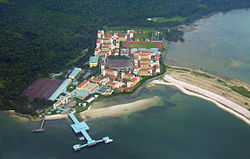North-Eastern Islands | |
|---|---|
From top left to right: Panorama of Chek Jawa, BMT training centre on Pulau Tekong, Huts in Pulau Ubin, Quarry in Pulau Ubin | |
 Location of the North-Eastern Islands in Singapore | |
| Coordinates: 1°24′52.9″N104°00′20.7″E / 1.414694°N 104.005750°E | |
| Country | |
| Region | North-East Region |
| CDC | |
| Town councils |
|
| Constituency | |
| Government | |
| • Mayor | South East CDC |
| • Member of Parliament | Pasir Ris–Changi GRC |
| Area | |
• Total | 42.8 km2 (16.5 sq mi) |
| Population | |
• Total | 40 |
| • Density | 0.93/km2 (2.4/sq mi) |
The North-Eastern Islands are a planning area and group of islands located within the North-East Region of Singapore. The cluster is made up of three islands, namely Pulau Tekong, Pulau Tekong Kechil and Pulau Ubin. Pulau Tekong and Pulau Tekong Kechil were formerly home to 10 villages while Pulau Ubin was home to a number of granite quarries. At present, Pulau Tekong houses the Singapore Armed Forces Basic Military Training Centre while Pulau Ubin is one of the last areas in Singapore that has been preserved from urban development, concrete buildings and tarmac roads. [3] [4]
Contents
The North-Eastern Islands share maritime boundaries with Changi, Pasir Ris and Punggol. The entire planning area is situated on the Straits of Johor.




